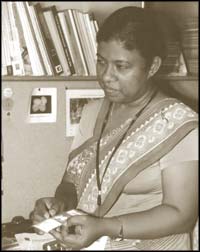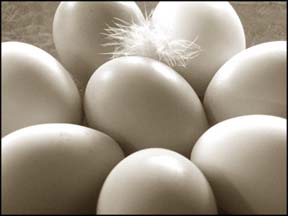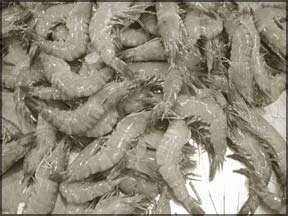[ SciTech]
Long-haul storage of fruits
ITI discovers new post-harvest technology:
by Dhaneshi YATAWARA
 |
|
Dr. Shanthi Wilson -
Head, Food Technology Division |
Sri Lanka, blessed with a tropical climate throughout the year
produces one of the best quality fruits. Though we have restricted
ourselves to imported apples, grapes and oranges in the recent past, Sri
Lanka boasts of a cocktail of fruits which are very high in nutritional
values. Yet, tragically we seem to be unaware of the fact.
"The quality of our fruits is very good. But we need to improve on
the post harvest technologies if we are to win the world market," said
Dr. Shanthi Wilson of the Sri Lanka Industrial Technology Institute (ITI).
Dr.Wilson heads the Food Technology unit of the ITI - a unit that brings
many novel innovations into the food industry of the country. "We are
passing on the technical know-how, especially to entrepreneurs in the
outstations. We have conducted several workshops and seminars through
the Ministry of Science and Technology at 'Vidatha' centres," Dr. Wilson
added.
Extended storage
ITI's food technology division, with a dedicated team of scientists,
has discovered many steps to improve the post harvest periods of the
food industry. Among the products especially catering to the fruits of
Sri Lanka, importantly to the export quality ones, waxes used to extend
the storage life of fruits during long distance transport. Fruits tend
to ripe and get damaged during transport because at the time of plucking
the fruits are already matured. "Fruits, especially for the export
quality ones, ripening while in transport is a problem. They need an
extended time," said Dr. Ms. Ilmi Hewajulige, a senior research officer
actively involved in post harvest technology research at the ITI.
 |
|
New wax produced by the ITI for longer
shelf life of fruits |
This wax, made with locally found ingredients, helps to extend the
storage life of fruits like papaya, pineapple, mangoes, bananas and even
for export quality king coconuts. "This wax would retain the green
colour of the matured fruit restricting the ripening process. After the
treatment fruits should be transported in cool storage," Dr. Hewajulige
explained.
This would encourage the fruit exporters to use sea transport where
more cargo can be transported at a lesser cost. More fruits will be
exported with a lesser expense to our local fruit farmers and traders
resulting more profits for the businesses. "Air transport is quicker but
if a businessman wants to send more it would be quite costly for him.
The problem with sea transport is that it takes comparatively a longer
time, depending on the destination. What we found is that if we can
delay the ripening process of these fruits, it can be retained as the
export quality until it reaches the destination," Dr. Wilson added.
Elaborating further Dr. Wilson added that this wax had shown
excellent results with mangoes which are prone to ripening very quickly.
The wax works with pineapple very well when applied to the fruit and not
to the crown. According to these scientists natural wax that covers the
crown is enough to protect it. With king coconuts, retaining the calyx
is essential to maintain the export quality as it tends to affect the
appearance of the nut. This wax prevents the calyx falling off from the
nut.
Waste prawn shells
 |
|
Dr. Ilmi Hewajulige
Senior Researcher |
In another research by Dr. Hewajulige a successful method was found
to extend the storage life of papaya using prawn waste material. Dr.
Hewajulige identified the antifungal activity of chitosan which is
extracted from the head and shell waste of prawns against the fungi of 'Colletotrichum'
species. Colletotrichum sp. is the common causative agent for post
harvest diseases.
"This solution works very well for the Rathna and Red lady varieties
of papaya, which are the most common varieties of papaya available in
Sri Lanka. This will extend the shelf life by 14 days," she further
explained. Dr. Hewajulige found this out when she was doing the
experiment on the Rathna variety. When these fruits were treated with an
aqueous solution of chitosan and stored at a low temperature at a
pre-identified maturity stage. This treatment extended the shelf life of
papaya for 14 days without any adverse effect on the flavour. Expanding
her studies further, Dr. Hewajulige found that the other variety - red
lady - though can not be preserved using only chitosan the storage life
could be expanded using chitosan subjected to gamma radiation. Even for
the Rathna variety can be extended further by extra seven days treating
with this irradiated chitosan.
To expand the export market of our precious fruits to those lucrative
markets in Europe and Middle East it is important to improve the post
harvest management practices to meet the stringent quality standards of
these countries.
Wonderful 'Lemna' to clean up dirty waters
 |
|
Common duckweed plant |
Mother Nature has her own wonderful phenomena. Her reactions are
quite unpredictable. Revealing these secrets of hers can be filled with
surprises to the human being; amidst the fact that humans do a greater
injustice to the nature by polluting the surroundings.
Pollution is totally created by the man. It is a by product of the
development and industrialisation, is not at fault. The man who creates
these innovations.
With such a background this article attempts to reveal a nature's way
of rectifying the error which humans create by releasing heavy metals to
water bodies through waste water. This contamination of water bodies by
heavy metals that come from industrial waste is a severe environmental
problem faced all over the globe. The normal practice is to remove these
pollutants through a chemical method. "Using the chemical method may
require some more steps to clean up the byproducts if any, produced as
result of these chemical reactions," said Dr. (Ms) Siththy Iqbal of the
Department of Chemistry of the Open University of Sri Lanka. Dr. Iqbal
along with her husband, Dr. M. C. M. Iqbal and their student Ms. Meena
Thayaparan conducted a research which produced a promising alternative
to this conventional clean-up method.
`Lemna' species
These three researchers, with findings from the National Science
Foundation's grant conducted an experiment with using the common
duckweed plant or scientifically known as `Lemna' sp. "Initially we used
about 12 floating and submerged aquatic plants. We restricted the study
to these floating and submerged aquatic plants since we were researching
on water ways," Thayaparan said. Checking 12 different floating and
submerged aquatic plants the researchers came to a conclusion that `Lemna'
species showed maximum absorption. It is a wonder the nature has passed
on to this tiny floating aquatic plant with elliptic leaves with faintly
visible veins. The researchers collected samples of selected aquatic
plants naturally growing in the waterways and started growing them in a
green house under similar conditions. These re-grown plants were used
for tests.
This is to make sure plants do not contain heavy metals before the
research.
They found `Lemna' was able to absorb the highest quality of
chromium. It was evident with the results that specific plants can be
used to remove specific metals from the polluted water sources. They
found within four days Lemna' absorbs the maximum amount. "After that
the plants need to be removed from the waterbody which we call as
'harvest' followed by a fresh community of Lemna' plants," Meena
explained. According to the researchers 'Lemna' can absorb up to 50% of
the chromium levels in the water sample.
Phytoremediation
 This method, scientifically known as phytoremediation is a modern
technology, using plant processes to remove, breakdown and make harmless
(detoxify) offensive metals and other toxic substances from contaminated
surroundings. Some plants have the ability to collect massive amounts of
heavy metals in their tissues without showing toxic symptoms. This
method has been widely practised to fix, restore and preserve polluted
sites throughout the world. This method, scientifically known as phytoremediation is a modern
technology, using plant processes to remove, breakdown and make harmless
(detoxify) offensive metals and other toxic substances from contaminated
surroundings. Some plants have the ability to collect massive amounts of
heavy metals in their tissues without showing toxic symptoms. This
method has been widely practised to fix, restore and preserve polluted
sites throughout the world.
Laboratory studies have confirmed that some water plants like 'Lemna'
sp. (as already explained), can absorb heavy metals like chromium,
cadmium, lead, mercury and nickel.
"We suggest to use this method in an artificial wetland - a manmade
site like a large pond or a tank to store waste or contaminated water -
and treat the water using this method," Dr. Siththy Iqbal said
explaining the practical side of the story. "The harvest can be
discarded in a proper manner for a hazardous waste," Meena added.
Experiments continue with these researchers as to check out the
ability of chosen water plants to mop up industrial waste contaminated
with these heavy metals.
According to the researchers some of these plants are also able to
take up heavy metals as their non-living biomass or better known as dry
matter, at times, offer a potential to be used as biofilters.
Cinnamon oil, new found preservative
A team of Greek researchers have found that cinnamon oil can be used
as a preservative in certain food applications due to its antifungal
activity. It is said that cinnamon oil may inhibit the growth of
micro-organisms by as much as 60%.
 Essential oils are known to be effective against wide spectrum of
micro-organisms and leave no detectable residues. Outcome of the
research may have considerable commercial significance and has a high
potential for oil vapour-enrichment. Essential oils are known to be effective against wide spectrum of
micro-organisms and leave no detectable residues. Outcome of the
research may have considerable commercial significance and has a high
potential for oil vapour-enrichment.
Time has come to return to natural sources of anti-fungal additives
from chemical bases. The reasons for this are manifold and include
general consumer preferences for natural foods, legislative changes and
the isolation of antibiotic resistant pathogens.
The team tested cinnamon oil in the range of 25 and 500 ppm for its
activity against certain fungi, including Colletotrichum coccodes,
Rhizopus stolonifer, Botrytis cinerea, Cladosporium herbarum and
Aspergillus niger. The invitro experiments showed that the anti-fungal
activity was related to the concentration of the essential oil. When the
25 ppm concentration was tested, a 63% reduction in the production of
the fungal spores was observed. At a concentration of 500 ppm, fungal
sporulation (except for B. cinerea) was completely retarded.
At present these researchers are mainly focusing on the mechanisms
underlying the impacts of essential oil volatiles on disease development
with a major contribution to limiting the spread of the pathogen by
lowering the spore load in the storage/transit atmospheres as well as
the use of essential oil as an alternative food preservative.n
(Source : ITI Bulletin vol.3)
New egg substitute
  An American company introduced a new substitute which can replace up
to almost 100 percent of eggs used in baked goods. These ingredients
could appeal to manufacturers who want to reduce the cost or even add
extra fibre into their products. It will help them to reduce the costs
eliminates one of the most common food allergens, creating possibilities
for better vegan baking. An American company introduced a new substitute which can replace up
to almost 100 percent of eggs used in baked goods. These ingredients
could appeal to manufacturers who want to reduce the cost or even add
extra fibre into their products. It will help them to reduce the costs
eliminates one of the most common food allergens, creating possibilities
for better vegan baking.
The product is marketed as a blend of sugarcane fibre, xanthan gumand
guar gum which can replace up to 100 percent of egg yolk and white in
baked foods such as muffins and cakes while maintaining the desirable
texture and appearance of the company. It is used at 20 percent of the
weight of the egg removed, by adding it to water to make up the
remaining 80 percent of egg weight.
Though egg prices have increased in the past year as a result of
increased cost of grain, they are important in providing the structure
and texture.n
(Source : ITI Bulletin vol.3)
ViduJaya from February 18 - 22
Celebrating the Golden Jubilee of the Sri J'pura
University:
The University of Sri Jayewardenepura will conduct 'ViduJaya' a
five-day exhibition from February 18 till February 22 celebrating its
Golden Jubilee.
Parallel to the exhibition, a series of lectures will be conducted
specially targeting the Advanced Level students featuring renowned
academics in the respective fields.
This lecture series will also be focusing on giving students an
introduction to the new A/L syllabus. Following lecture series will be
conducted from 19 - 23 February (except on February 22) as two lecture
sessions daily from 1.00 p.m. to 2.30 p.m. and from 3.00 p.m. to 4.30
p.m. at the Chemistry Lecture Hall 1 (C1).
February 19: For Biology,
Prof. H. G. Nandadasa from the Department of Botany, Dr. Hiran
Amarasekara - Head, Dept. of Forestry and Environment Science Mr. C.M.R
Anthony - Director, the National Institute of Education
February 20: For Physics,
Dr. S. D. Rosa - Senior Lecturer from the University of Colombo
February 21: For Combined Mathematics,
Senior Lecturers G.I.K. Silva and K.K.W.A. Sarath Kumara
February 23: For Chemistry,
Prof. S.P. Deraniyagala and Dr. Sudantha Liyanage
More lectures and educating sessions will also be conducted during
the exhibition period especially on subjects related to improving
rubber, food, and agriculture related industries.
Discussions on preserving the environment, forestry management and
many other timely topics are scheduled to be conducted by renowned
lecturers and experts in the field.
Chitosan
With the findings from the Industrial Technology Institute to extend
the storage life of papaya using papaya, it would be interesting to know
something more about usages of chitosan. Chitosan is produced
commercially by deacetylation of chitin, which is the structural element
in the exoskeleton of crustaceans (crabs, shrimp, etc.).
 Given its low potential for toxicity and its abundance in the natural
environment, chitosan is not expected to harm people, pets, wildlife, or
the environment when used according to label directions. Given its low potential for toxicity and its abundance in the natural
environment, chitosan is not expected to harm people, pets, wildlife, or
the environment when used according to label directions.
Chitosan is a linear polysaccharide composed of randomly distributed
â-(1-4)-linked D-glucosamine (deacetylated unit) and N-acetyl-D-glucosamine
(acetylated unit). It has a number of commercial and possible biomedical
uses. In agriculture, chitosan is used primarily as a plant growth
enhancer, and as a substance that boosts the ability of plants to defend
against fungal infections. It is approved for use outdoors and indoors
on many plants grown commercially and by consumers.
Chitosan can also be used as a part of a water filtration process.
Chitosan causes the fine sediment particles to bind together and is
subsequently removed with the sediment during sand filtration. Chitosan
also removes phosphorus, heavy minerals, and oils from the water.
Chitosan is an important additive in the filtration process. Chitosan,
in combination with bentonite, gelatin, silica gel, isinglass or other
fining agents is used to clarify wine, mead, and beer. Added late in the
brewing process, chitosan improves flocculation, and removes yeast
cells, fruit particles, and other detritus that cause hazy wine.
Chitosan combined with colloidal silica is becoming a popular fining
agent for white wines, because chitosan does not require acidic tannins
(found primarily in red wines) to flocculate with.
Chitosan has been used to precipitate caseins from bovine milk and
cheese making.
Chitosan is hypoallergenic, and has natural anti-bacterial
properties, further supporting its use in field bandages.
Chitosan is also famous in the world as a `fat attractor': It is
supposed to have the capability of attracting fat from the digestive
system and expelling it from the body so that users can, it is claimed,
lose weight without eating less. However, some scientific research
suggests that these claims are likely without substance. (Source :
Internet) |


